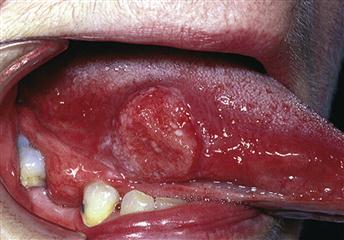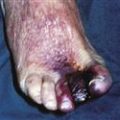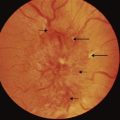Tongue Disorders
Tongue disorders are extremely common, ranging from minor furring of the tongue to extensive inflammation and malignancy. Tongue disorders are often a manifestation of systemic disease.
History
Furring
A history of gastrointestinal disease, dehydration, mouth breathing, smoking or antibiotics.
Colour change
White patches on the tongue are suggestive of leucoplakia or candidiasis, the last being associated with antibiotic therapy, chemotherapy or immunosuppression. Hairy leucoplakia is associated with EBV and is found almost exclusively in patients with HIV. A pale tongue may indicate anaemia, a blue tongue central cyanosis. The patient may present with a red, painful tongue, which may occur in pernicious anaemia or other forms of vitamin B deficiency. Pigmentation may be a sign of Addison’s disease.
Swelling
The patient may present with a swollen tongue, which may or may not be painful. Difficulty in articulation or swallowing may be apparent. Congenital hypothyroidism (formerly known as cretinism) will be obvious (extremely rare nowadays), as will Down’s syndrome. A swollen tongue may be a presentation of myxoedema. Other symptoms of myxoedema may be present, e.g. slowness, weight gain, dry skin, hoarse voice, constipation, lethargy, dislike of cold weather. Acromegaly may be obvious, the patient having noticed an increase in shoe size, change in voice and jaw changes. Infection (see below) may present with swelling, as may allergies or trauma, especially burns with hot fluids or caustic substances. Infection will result in a painful tongue, the classical predispositions to chronic superficial glossitis being the six Ss: syphilis, smoking, spices, spirits, sepsis, sharp teeth.
Chronic superficial glossitis
There is a sequence of chronic inflammatory, degenerative and hypertrophic changes in the tongue, which terminate in the development of a carcinoma. There may be a history of the six Ss: syphilis, smoking, sharp tooth, spirits, spices and sepsis. The patient is usually over the age of 50 and presents with a tongue that has become shiny or white, or has developed a lump on the tongue. There is usually no pain and no interference with eating.
Ulceration
Ulceration is common. Aphthous ulcers are painful and are often associated with chronic debilitating disease. Dental trauma from a sharp tooth or ill-fitting dentures may cause ulcers. Chancre and gumma associated with syphilis are rare. Carcinoma has a peak incidence at 60–70 years and presents with a painless ulcer on the tongue, often at the margins on the dorsal surface. Carcinoma of the posterior third of the tongue may present with referred pain to the ear, the pain being referred from the lingual branch of the trigeminal nerve, which supplies the tongue, to the ear, via the auriculotemporal nerve.
Examination
Furring
Examination will reveal uniformed furring of the tongue. Note its colour. Look for signs of gastrointestinal disease.
Colour change
This will usually be obvious. White patches on the tongue may be due to leucoplakia. The white plaques may fissure with time. This is a pre-malignant condition. Other white patches may be due to candidal infection (thrush). Unlike leucoplakia, these white plaques may be rubbed off, revealing ulcerated buccal mucosa underneath. Colour changes may be uniform (pallor and cyanosis) or patchy (the pigmentation of Addison’s disease). In pernicious anaemia the tongue is red, bald and painful.
Swelling
The tongue is large and tends to protrude in Down’s syndrome. Other signs of Down’s syndrome will be apparent, e.g. epicanthic folds, mental retardation. Look for signs of congenital hypothyroidism, e.g. stunted growth, relatively large head, thick eyelids, thick broad nose, thick lips, widely spaced eyes. With myxoedema, there will be dry skin, dry hair, goitre, slow relaxing reflexes, congestive cardiac failure and non-pitting oedema. With acromegaly, there will be large feet, prognathism, thick spade-like hands, deep voice and possibly cardiac failure. In generalised infections, the tongue will be red and swollen. Allergies may present with a swollen tongue, lips, larynx, bronchospasm and rash. There will usually be a history of exposure to an allergen. The ingestion of corrosive or hot fluids will result in inflammation not only to the tongue but also to the rest of the mouth and the pharynx.
Chronic superficial glossitis
Examination reveals a thin, grey transparent film on the tongue in the early stages. Leucoplakia occurs next and eventually overt carcinoma develops.
Ulceration
Aphthous ulcers start as tender vesicular lesions with a hyperaemic base, which ulcerate leaving a small, white, circular, deep, painful ulcer. Dental trauma will usually result in ulcers at the lateral margins of the tongue adjacent to a sharp tooth. Chancres and gummas are rare, as is tuberculous ulcer of the tongue. A carcinomatous ulcer usually occurs on the upper surface of the tongue, most often at the lateral margins. It feels hard, has an everted edge, is friable and bleeds. Local lymph nodes may be palpable, due to either secondary infection or metastases.
Wasting
Ask the patient to protrude the tongue. Wasting will be noted on the affected side and the tongue deviates to the side of the lesion. Check for scars on the neck to suggest hypoglossal nerve damage.





